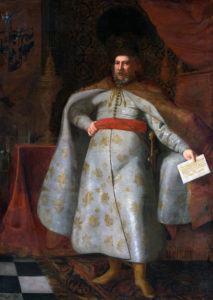
© Liechtenstein. The Princely Collections, Vaduz – Vienna, Inv. No: Kupfer GE 1007
Johann Rudolf Schmid von Schwarzenhorn – a Swiss gentleman at the Sultan’s court
While the 16th and 17th-century ‘fear of the Turks’ is still present in the collective consciousness of Central Europe, very few people are aware that there are also numerous examples of a lively cultural exchange during the same period. Right in the thick of it was a Swiss man, Johann Rudolf Schmid von Schwarzenhorn, born in 1590 in Stein am Rhein.
An unusual painting by Dutch artist Jeronimus Joachims (1619-1660), who worked in Vienna, depicts Johann Rudolf Schmid von Schwarzenhorn (1590-1667) as Habsburg ambassador at the height of his career, at the court of the Ottoman Sultan Mehmed IV in Istanbul in 1651 (show full picture). But how did a Swiss man, more precisely a middle-class boy from Stein am Rhein, come to be a Habsburg diplomat? And to have his portrait painted in Vienna by an artist from the Netherlands, Jeronimus Joachims?
From the Rhine to the Bosphorus
Johann Schmid was born in 1590, the son of Stein alderman Felix Schmid and his wife, Elisabeth, née Hürus, daughter of a Constance aristocrat. Following the early death of his father, the large family was left in a difficult financial situation. It was probably an uncle, Andreas Hürus, an officer in the service of the Habsburg Emperor, who took the boy in. In 1604 this uncle died in the Long Turkish War in Hungary. Johann Schmid was captured, becoming a slave under Turkish-Islamic martial law. Many years later, Schmid resurfaced as a translator at the court of the Sultan in Istanbul – he spoke not only Ottoman Turkish, but also Italian and French. His freedom bought by the Habsburgs, Schmid came to Vienna in 1624. This was the start of an unprecedented career. In 1629, Johann Schmid returned to Istanbul as diplomat to the ‘Sublime Porte’, and remained there as imperial envoy for fourteen years. His most important task was preventing the Ottomans from entering the war against Austria. From the end of 1643 he was a member of the Court Council of War of the Habsburg Monarchy in Vienna. In 1647 he was ennobled, and in 1650 he was elevated to the rank of Baron of the Holy Roman Empire (Reichsfreiherr). A number of missions took him back to the Ottoman court in Istanbul including, in 1650/1651, an assignment as ambassador for the presentation to Sultan Mehmed IV of the peace agreement signed by Emperor Ferdinand III. This was the high point of his career. He died in Vienna on 12 April 1667, and was buried in the crypt of the Schottenstift.

‘Haus zum Schwarzen Horn’: Johann Rudolf Schmid’s birthplace in Stein am Rhein. The wall painting dates from 1914 and depicts an imagined scene of the baron entering Stein am Rhein in 1664.
Wikimedia / Jacques Verlaeken
Master of self-presentation
His life story is remarkable enough, but so is the way he presented himself. In the 1651 painting by Jeronimus Joachims referred to above, he had himself depicted in the robes he wore as ambassador for an audience with Sultan Mehmed IV. This outfit was not Habsburg European clothing, but ‘Hungarian’ – that is, strongly based on the Ottoman style, and as such was made mandatory for European envoys by the Sultan’s court until 1699. It consisted of the ‘dolman’ (the tunic), the ‘kaftan’ (an overgarment), a headdress with a plume of feathers, and leather boots. This garb implicitly defined the wearer’s ceremonial rank as emissary of the Hungarian King, and thus not as that of the Habsburg Emperor (who was king of a portion of Hungary in personal union). It therefore expressed not equal status, but subordination. And yet, for Schmid von Schwarzenhorn, the splendour of his robes of precious silk, embroidered in gold and silver threads with the motifs of flowers and leaves so beloved of the Ottomans, apparently symbolised the high point of his career so powerfully that all other considerations were disregarded. In fact, in 1651 Schmid von Schwarzenhorn was the first Habsburg envoy to pose proudly for his formal portrait in this ‘Hungaro-Ottoman’ clothing.
Schmid von Schwarzenhorn also made very deliberate arrangements for his own legacy. He endowed his hometown of Stein an Rhein with another portrait painting and a unique silver-gilt lidded chalice, depicting his remarkable career in decorative figures. The template for this – provided via a copperplate engraving – was the painting by Jeronimus Joachims. Schmid decreed that every time someone drank from this chalice, the story of his life must be read out – this is still done to this day, in what is known as the ‘Becherzeremonie’ in Stein am Rhein.
A modern biography
As a result of his many years in Ottoman captivity and as interpreter for the Ottomans, Johann Schmid knew the power structure of the Ottoman court, which was completely different from European conditions, was familiar with the Ottoman culture and spoke Ottoman Turkish fluently. His advancement and his success were based not, as would be expected in the 17th century, on his origins and wealth, but on his cross-cultural expertise and his language skills – a thoroughly modern life story. In addition, he went to creative and very original lengths to make sure his accomplishments as a peacemaker, as he wanted to be seen, would not be forgotten.
War and peace were the pivotal aspects in Johann Rudolf Schmid von Schwarzenhorn’s diplomatic career. The intertwining of Islamic-Eastern and Christian-Western cultural circles, moving between conflict and cultural transfer, becomes clearly evident. The question of the complex relationship between Orient and Occident, no less topical today than it was then, is fundamental to his story.

Silver-gilt lidded chalice, 1660.
Stein am Rhein, Rathaussammlung (Town Hall Collection). Photo: © Kultureinrichtungen Jakob und Emma Windler-Stiftung, Stein am Rhein

Silver-gilt lidded chalice, detail.
Stein am Rhein, Rathaussammlung (Town Hall Collection). Photo: © Kultureinrichtungen Jakob und Emma Windler-Stiftung, Stein am Rhein

Nikolaus van Hoy, Schmid von Schwarzenhorn as benefactor, 1660.
Stein am Rhein, Rathaussammlung (Town Hall Collection). Photo: SIK-ISEA, Zurich (Philipp Hinz)
Tip
Featuring around 350 priceless objects, the exhibition ‘Emperor and Sultan’ at the Badisches Landesmuseum (State Museum of Baden) in Karlsruhe presents the history of the Occident and the Ottoman Empire, moving between conflict and cultural exchange. Until 19 April 2020. landesmuseum.de
There is more on Johann Rudolf Schmid von Schwarzenhorn in the exhibition catalogue ‘Emperor and Sultan. Neighbours in the Heart of Europe 1600-1700’, published by the Badisches Landesmuseum, Hirmer: Munich 2019.



